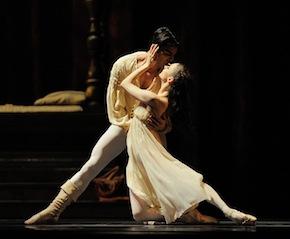
Photos by Erik Tomasson
San Francisco Ballet’s week of Romeo and Juliet began in stunning fashion Tuesday night. Choreographed for the company by artistic director Helgi Tomasson in 1994, it was restaged in 2010 with a set by Jens-Jacob Worsaae, that is as full of moonlight and sunshine, romance and sorrow, as the Shakespeare tale itself.
The power of the company’s production resides not only in the extraordinary dancing — highlighted Tuesday by Maria Kochetkova’s Juliet — but in the entire cast’s devotion to story as well as to steps, to shadings of emotion and twists of fate. The clarity of every moment, accentuated by the orchestra under the baton of Martin West, added up to a powerful evening of theater as well as dance.
Powerful, and soaring. Tomasson’s choreography uses Prokofiev as a catapult, taking flight even at the moments of greatest conflict or anguish — Juliet, running from her father’s demands that she marry Paris; Mercutio, hiding his fatal wound at the hands of Tybalt. As created by some dancemakers (I’m thinking especially of Kenneth MacMillan’s version at American Ballet Theatre), “Romeo and Juliet” struggles against the music, like a ship tossing at anchor. This isn’t always a bad thing; there are some great moments in MacMillan’s work. But Tomasson’s is an elevating, inspiriting show.
Related Article
Dream a Big Dream: The Nutcracker at S.F. Ballet
December 9, 2011
S.F. Ballet Brings Coppélia Vividly to Life
March 19, 2011
Maria Kochetkova is notable for the way she uses her own physicality, especially that slender fragility, both to depict Juliet’s immaturity — she truly looks like a little girl — and then her full-bodied elation after her night with Romeo (the superb Joan Boada), visibly underscored by sorrow. The complexity of her portrayal is echoed in her technique. The fluttery unfolding of a developpe as she’s lifted in Boada’s arms, for example, during the masked ball sequence, conveys both her adolescent hesitancy and her burgeoning maturity. Kochetkova’s natural ease, her elevation, her inborn dramatic facility all made her performance extraordinary.

As Mercutio, Romeo’s wingman, Gennadi Nedgivin continues on his remarkable trajectory with the company. His technique is balanced by his acting ability and his impeccable sense of timing. He’s funny, he’s tragic. He has amazing spins and leaps, including a few that probably don’t have names yet, and his sense of comedy is a match for his velocity. When he was killed by Tybalt (a satisfyingly stalking Daniel Deivison) it was a terrible moment; you knew you’d miss him for the rest of the ballet.
The company looks remarkably in tune. The citizens of the beautiful golden-walled city of Verona, who include students from the San Francisco Ballet School, perform with hearty conviction. The ballet’s smaller roles are presented as attentively as the larger ones. Particular note must be given to the gravity-defying acrobatics of Dores Andre and the two Stewarts, Benjamin and Matthew; the harlots, who as enacted by Courtney Elizabeth and Shannon Roberts, were high-spirited hussies with legs as well as hearts of gold; Anita Paciotti’s loving warmth as Juliet’s nurse, and Jaime Garcia Castilla’s Benvolio, with technique that was a match for his compadres Romeo and Mercutio, particularly in their delightful high-flying trio.

